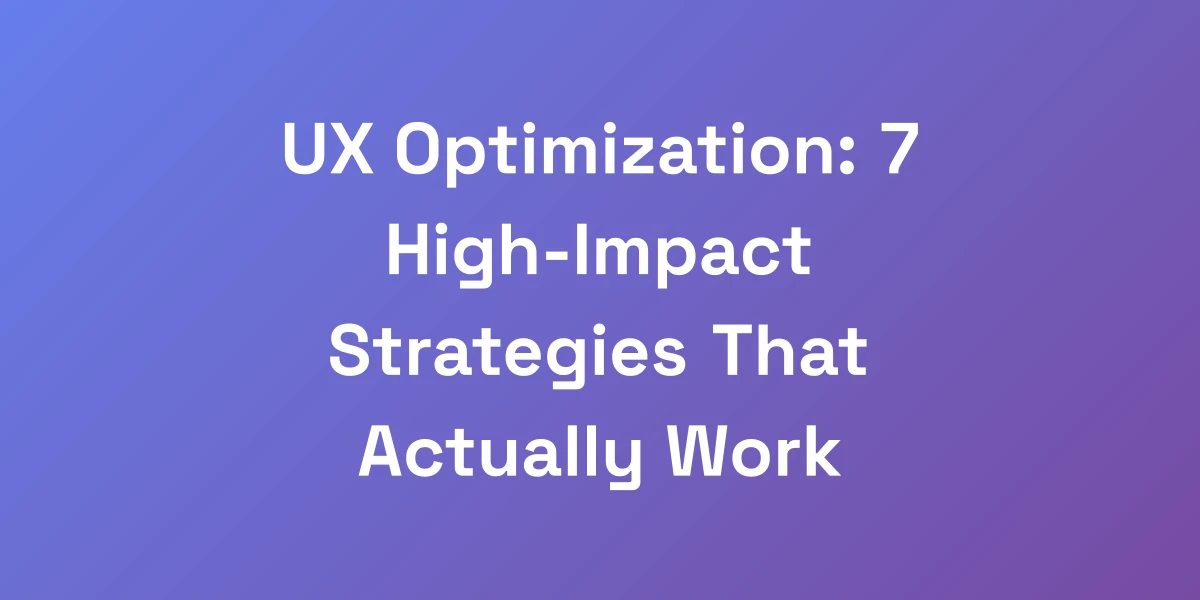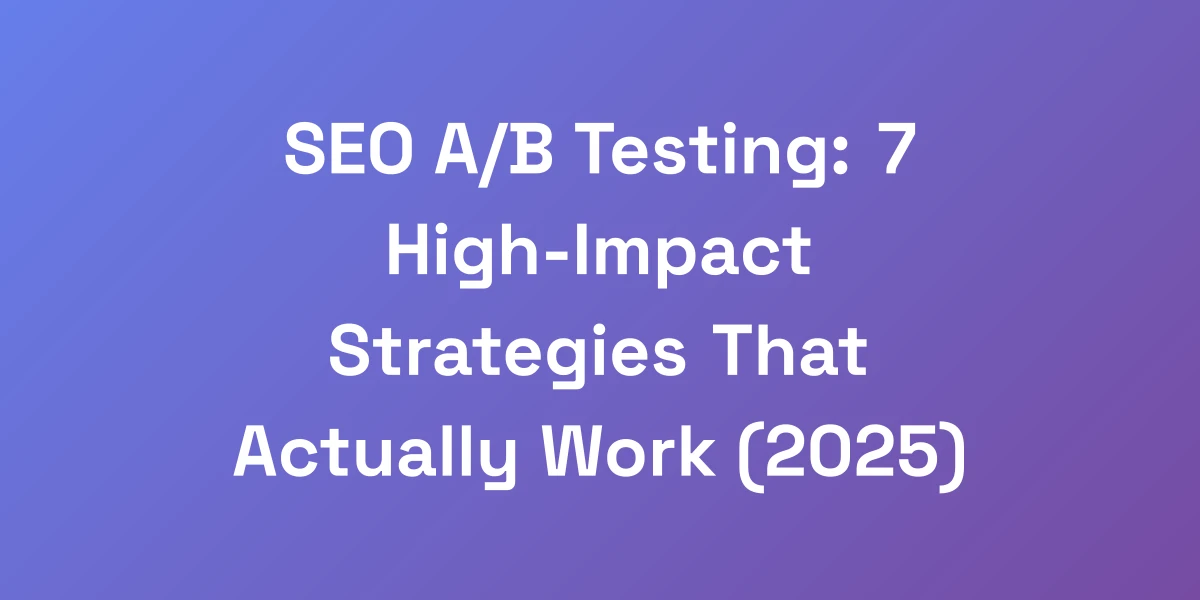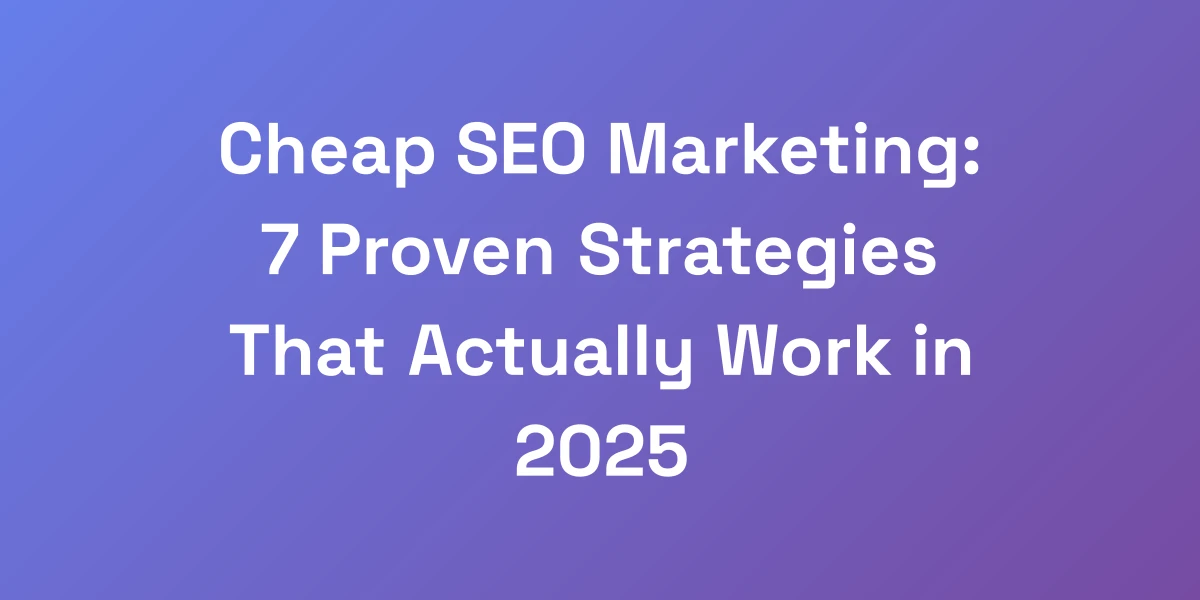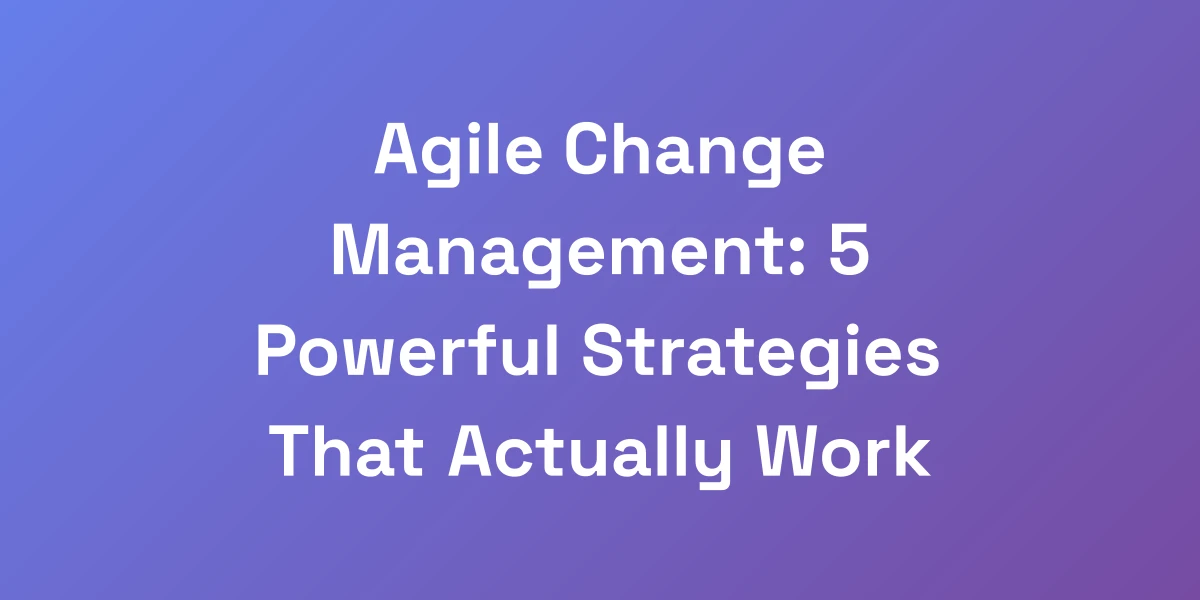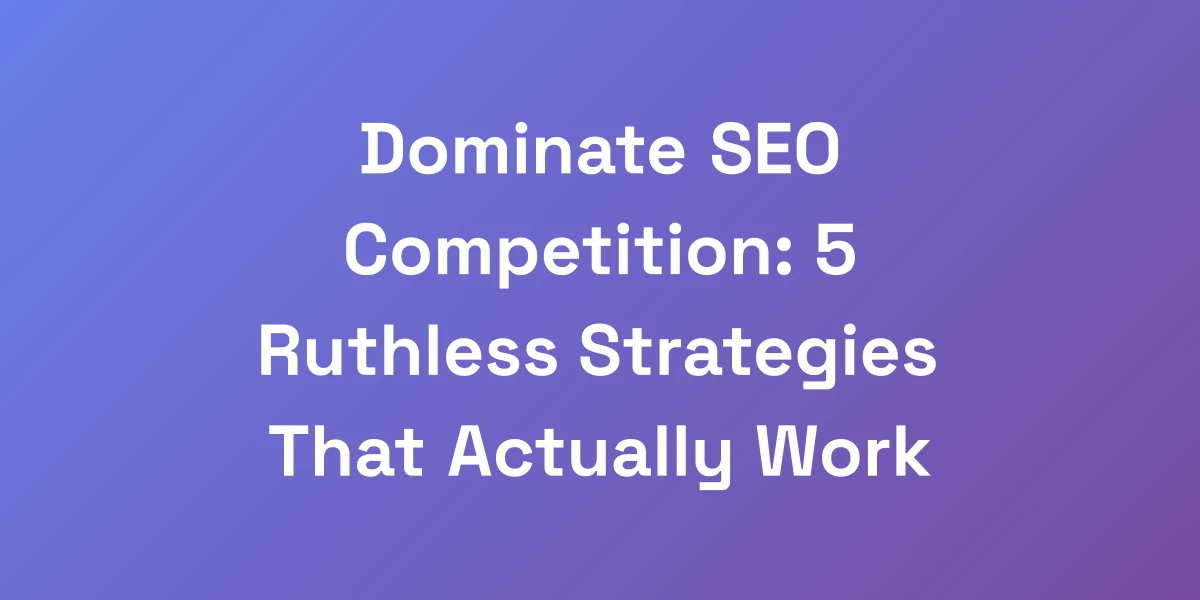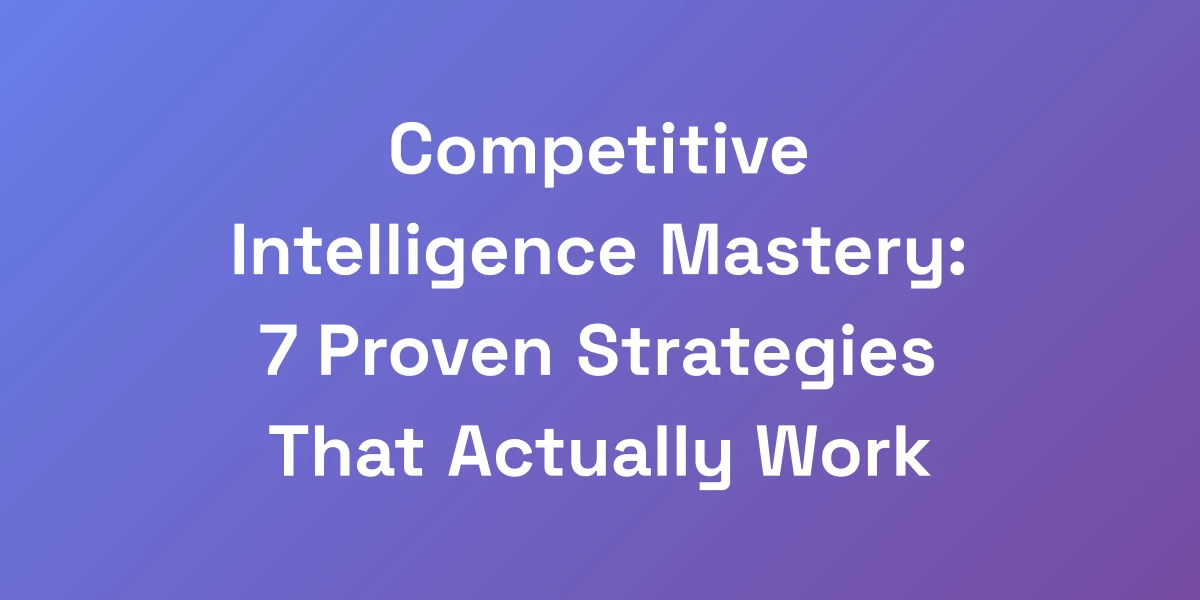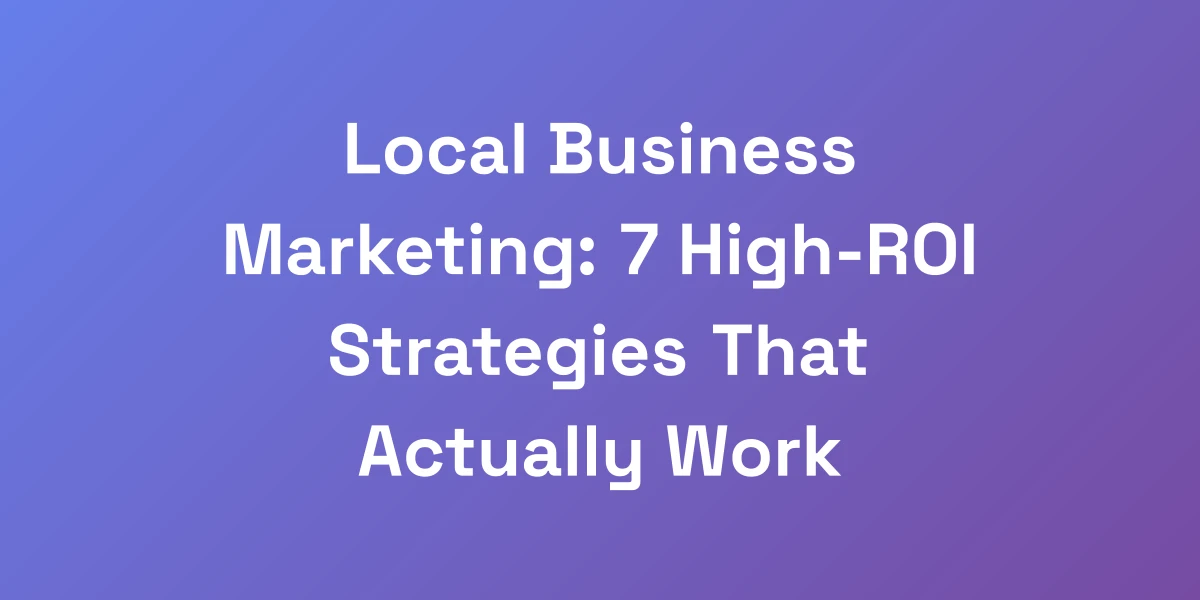
Local Business Marketing: 7 High-ROI Strategies That Actually Work
Mar 6, 2025 | By [email protected]
Let’s get straight to the point: if you’re running a local business, traditional marketing tactics are draining your budget without delivering the results you deserve. We’ve all seen it—throwing money at ads that vanish into the void and posting on social media only to hear crickets. Here’s the kicker: the game has changed. The businesses that are thriving today aren’t just following outdated playbooks; they’re pioneering new strategies that turn every marketing dollar into tangible revenue. Imagine transforming your marketing efforts into a systematic revenue engine that seamlessly blends SEO Automation with real-world impact. Intrigued? You should be. We’re about to dive deep into the exact strategies that will propel your local business marketing to new heights. Ready to leave your competitors in the dust? Let’s break it down.
Why Most Local Businesses Fail at Marketing (And How to Win)
Let’s face it: 82% of local businesses struggle with marketing. Why? Because they’re stuck in a cycle of ineffective strategies and lack a clear plan, SEO for startups. Without a structured approach, it’s easy to waste time and resources on tactics that don’t drive results.
The New Rules of Local Marketing
Gone are the days when simply having a presence was enough. Today, local marketing demands a strategic, data-driven approach. It’s not just about being seen; it’s about being seen by the right people at the right time.
- Data-Driven Decisions: Utilize local market data to inform your strategies. Understand your audience’s behavior and preferences.
- Integrated Marketing Efforts: Combine online and offline strategies for a cohesive approach.
- Continuous Optimization: Regularly assess and tweak your strategies based on performance metrics.
Why Traditional Methods Are Dying
Traditional marketing methods like print ads and generic online ads are becoming less effective. Consumers are bombarded with countless messages daily, making it harder for your business to stand out.
- Lack of Targeting: Traditional ads often miss the mark in reaching the right local audience.
- High Costs: These methods can be expensive with questionable ROI.
- Low Engagement: Consumers are more likely to ignore generic ads, reducing their effectiveness.
The ROI-First Approach to Local Marketing
Focusing on ROI means prioritizing strategies that deliver measurable results. It’s about maximizing every dollar spent to ensure it contributes to your bottom line.
- Set Clear Goals: Define what success looks like for your marketing campaigns.
- Track Metrics: Use tools to monitor the performance of your marketing efforts.
- Adjust Accordingly: Be prepared to pivot strategies based on what the data tells you.
Understanding Your True Customer Acquisition Cost
Knowing the average customer acquisition cost is crucial for budgeting and strategy planning. It helps you allocate resources effectively and identify the most profitable channels.
- Calculate CAC Accurately: Include all marketing and sales expenses.
- Compare Across Channels: Determine which channels provide the best ROI.
- Optimize for Efficiency: Focus on reducing CAC while maintaining acquisition rates.
Setting Up Your Marketing Success Metrics
To measure the effectiveness of your marketing strategies, you need to establish key performance indicators (KPIs).
- Define KPIs: Examples include lead generation, conversion rates, and customer retention.
- Use Analytics Tools: Tools like Google Analytics and SEO for freelancers can provide valuable insights.
- Regularly Review and Adjust: Assess your KPIs regularly and make necessary adjustments.
Dominating Your Google Business Profile (The Underground Playbook)
Your Google Business Profile (GBP) is more than just an online listing—it’s a 24/7 sales machine. Most businesses only scratch the surface, missing out on potential revenue. The magic lies in leveraging specific psychological triggers and understanding Google’s local algorithm to enhance visibility and engagement.
Advanced GBP Optimization Tactics
Optimizing your GBP goes beyond filling out basic information. It involves strategic enhancements such as SEO optimization automation to boost your profile’s performance.
- Complete Every Section: Ensure all information is accurate and comprehensive.
- Use Targeted Keywords: Incorporate local keywords seamlessly into your profile.
- Regular Updates: Keep your profile fresh with the latest information and offers.
Review Generation System
Positive reviews are gold for local businesses. They build trust and significantly impact your local search rankings.
- Encourage Reviews: Prompt satisfied customers to leave reviews.
- Respond to Feedback: Engage with both positive and negative reviews professionally.
- Highlight Top Reviews: Showcase the best reviews to attract new customers.
Photo and Video Optimization Secrets
Visual content is crucial for engaging potential customers. High-quality images and videos can make your GBP stand out.
- High-Resolution Images: Use clear, professional photos of your business and products.
- Video Content: Short, informative videos can increase engagement and conversions.
- Consistent Branding: Ensure all visual content aligns with your brand identity.
Q&A Strategy for Maximum Visibility
Utilizing the Q&A feature on GBP can address customer inquiries proactively and improve your profile’s SEO.
- Anticipate Questions: Identify common queries and provide clear, concise answers.
- Monitor and Respond: Regularly check for new questions and respond promptly.
- Optimize Content: Use relevant keywords in your responses to boost SEO.
Local Pack Ranking Factors
Understanding the factors that influence your ranking in Google’s Local Pack is essential for dominating local search results.
- Relevance: Ensure your GBP is relevant to the search queries.
- Distance: Proximity to the searcher impacts your ranking.
- Prominence: Your business’s online presence and reputation play a key role.
Conversion Rate Optimization for GBP
Turning profile views into actual customers requires specific tactics aimed at increasing your conversion rates.
- Clear Call-to-Actions: Make it easy for customers to take the next step.
- Streamlined Booking Processes: Simplify the process for appointments or purchases.
- Engaging Content: Use compelling descriptions and visuals to entice action.
The Local Content Ecosystem That Prints Money
Content marketing is a powerhouse when done right. For local businesses, it needs to be hyperlocal and action-oriented to drive foot traffic and sales.
Hyperlocal Content Framework
Create content that resonates with your local audience by focusing on localized marketing examples.
- Community Stories: Share stories that highlight local culture and events.
- Local Guides: Create guides that help locals navigate services and attractions.
- Customer Spotlights: Feature local customers and their experiences with your business.
Local SEO Content Mapping
Strategically map your content to align with local search intent, ensuring you rank for the right keywords.
- Keyword Research: Identify and use location-specific keywords.
- Content Clusters: Develop content around central themes relevant to your locality.
- On-Page SEO: Optimize your content with local SEO best practices.
Social Proof Integration
Integrate social proof into your content to build trust and credibility with your local audience.
- Testimonials: Highlight positive feedback from local customers.
- Case Studies: Showcase successful local projects or collaborations.
- User-Generated Content: Encourage and feature content created by your customers.
Location-Based Keywords Strategy
Utilize keywords that are specific to your location to enhance your local search rankings.
- Long-Tail Keywords: Use detailed keywords that reflect local search intent.
- Geo-Modifiers: Incorporate terms that specify your city, neighborhood, or region.
- Competitive Analysis: Identify and target keywords that your competitors are ranking for.
Content Distribution Networks
Ensure your content reaches your local audience through the right channels.
- Local Blogs and Websites: Partner with local platforms to share your content.
- Social Media: Use local hashtags and groups to distribute your content.
- Email Marketing: Send targeted content to your local email subscribers.
Measuring Content ROI
Track the performance of your content to ensure it’s delivering the desired results.
- Engagement Metrics: Monitor likes, shares, and comments to gauge interest.
- Conversion Tracking: Measure how content leads to sales or other desired actions.
- Analytics Tools: Use tools like Google Analytics to assess content effectiveness.
Community-Based Marketing That Scales
Community marketing isn’t just about participating in local events; it’s about creating a systematic and scalable approach that fosters long-term relationships and generates predictable returns.
Event Marketing Architecture
Design events that not only engage the community but also align with your business goals.
- Strategic Planning: Plan events that reflect your brand and meet community interests.
- Promotion: Use multiple channels to promote your events to ensure maximum attendance.
- Follow-Up: Engage with attendees post-event to convert them into customers.
Local Partnership Framework
Forge partnerships with other local businesses to expand your reach and resources.
- Identify Synergies: Partner with businesses that complement your offerings.
- Joint Promotions: Collaborate on promotions that benefit both parties.
- Resource Sharing: Share resources and knowledge to enhance mutual growth.
Community Engagement Systems
Implement systems that continuously engage the community and keep your business top-of-mind.
- Consistent Communication: Maintain regular contact through newsletters and updates.
- Interactive Platforms: Use social media and community forums to interact with locals.
- Feedback Loops: Encourage and act on community feedback to improve offerings.
Referral Program Design
Create referral programs that incentivize your existing customers to bring in new ones.
- Attractive Incentives: Offer rewards that motivate customers to refer others.
- Simplified Process: Make it easy for customers to refer friends and family.
- Track Referrals: Monitor and reward successful referrals to maintain momentum.
Local Influence Network
Leverage local influencers to amplify your marketing efforts and reach a broader audience.
- Identify Influencers: Find influencers who resonate with your target audience.
- Build Relationships: Develop genuine relationships to ensure authentic collaborations.
- Measure Impact: Track the effectiveness of influencer partnerships on your business.
Measuring Community Impact
Assess the effectiveness of your community-based marketing strategies to ensure they’re driving results.
- Engagement Levels: Monitor participation and interactions in your community initiatives.
- Brand Awareness: Measure changes in local brand recognition and perception.
- Sales Metrics: Track sales growth linked to community marketing efforts.
Digital-Physical Integration Tactics
The real magic happens when online efforts seamlessly interact with your physical presence. Bridging the gap between digital and physical marketing can transform every customer interaction into a powerful engagement.
QR Code Marketing Systems
QR codes can be a simple yet effective way to connect your physical storefront with your digital presence.
- Strategic Placement: Place QR codes in high-traffic areas within your store.
- Incentivize Scans: Offer discounts or exclusive content to encourage customers to scan.
- Track Performance: Use analytics to monitor how often QR codes are scanned and adjust accordingly.
Location-Based Advertising
Target your advertising efforts based on specific locations to ensure your message reaches the right audience.
- Geo-Fencing: Create virtual boundaries to target customers within a specific area.
- Local Ads: Use platforms like Google Ads and Facebook to run location-specific campaigns.
- Hyper-Targeted Offers: Provide special deals to customers in targeted locations.
SMS Marketing Automation
SMS marketing allows you to reach customers directly on their mobile devices with timely and relevant messages.
- Automated Campaigns: Set up automated texts for promotions, reminders, and follow-ups.
- Personalization: Tailor messages to individual customer preferences and behaviors.
- Compliance: Ensure all SMS marketing efforts comply with local regulations and opt-in requirements.
Digital-Physical Customer Journey
Map out the customer journey to ensure a seamless transition between online interactions and physical experiences.
- Consistent Branding: Maintain consistent messaging and branding across all touchpoints.
- Integrated Systems: Use CRM and marketing automation tools to unify online and offline data.
- Customer Feedback: Collect and utilize feedback to refine the customer journey continuously.
Cross-Channel Attribution
Understand how different marketing channels work together to drive conversions and optimize your strategy accordingly.
- Unified Tracking: Implement tracking systems that monitor customer interactions across all channels.
- Attribution Models: Use models like first-touch, last-touch, or multi-touch to attribute conversions accurately.
- Data Analysis: Analyze cross-channel data to identify the most effective combinations of tactics.
Offline-to-Online Conversion
Turn your offline customers into loyal online supporters by encouraging digital interactions.
- In-Store Promotions: Offer incentives for customers to connect with your business online.
- Digital Signage: Use screens in your store to promote online content and offers.
- Feedback Collection: Encourage customers to leave online reviews after their in-store experience.
The Local Social Media Blueprint
Social media for local businesses isn’t about amassing followers—it’s about driving local sales through strategic, proximity-based engagement.
Platform-Specific Local Strategies
Each social media platform has unique features and user demographics. Tailor your strategies to leverage each platform effectively.
- Facebook: Utilize local groups and targeted ads to reach your community.
- Instagram: Share visually appealing, location-specific content to attract followers.
- Nextdoor: Engage with neighbors and local communities through this hyperlocal platform.
Content Calendar Architecture
Plan your content in advance to maintain consistency and ensure you’re covering all necessary topics.
- Monthly Themes: Assign themes to focus your content around specific topics each month.
- Consistent Posting: Maintain a regular posting schedule to keep your audience engaged.
- Flexible Planning: Allow room for spontaneous content based on current events or trends.
Engagement Automation
Automate repetitive tasks with marketing automation for agencies to maintain consistent engagement without overwhelming your resources.
- Automated Responses: Set up responses for common inquiries to ensure timely engagement.
- Scheduling Tools: Use tools like Hootsuite or Buffer to schedule posts in advance.
- Chatbots: Implement chatbots to handle initial customer interactions automatically.
Local Hashtag Strategy
Use local hashtags to increase the visibility of your posts among your target community.
- Research Popular Hashtags: Identify hashtags that are trending in your local area.
- Create Branded Hashtags: Develop unique hashtags that represent your brand and encourage customer use.
- Monitor Performance: Track which hashtags are driving the most engagement and adjust accordingly.
Ad Targeting Framework
Optimize your social media ads to reach the most relevant local audience effectively.
- Geo-Targeting: Focus your ads on specific geographic locations to ensure local relevance.
- Demographic Targeting: Tailor your ads based on age, gender, interests, and other demographic factors.
- Retargeting: Use retargeting strategies to re-engage users who have interacted with your business before.
ROI Tracking Systems
Measure the effectiveness of your social media efforts to ensure they’re delivering the desired returns.
- Set Clear Metrics: Define what success looks like, whether it’s increased sales, leads, or engagement.
- Use Analytics Tools: Leverage tools like Facebook Insights and Instagram Analytics to track performance.
- Adjust Strategies: Use the data to refine your strategies and focus on the most effective tactics.
Conclusion
We’ve covered some powerful strategies that can transform your local business marketing efforts from mediocre to exceptional. By understanding the new rules, optimizing your Google Business Profile, creating a robust local content ecosystem, scaling community marketing, integrating digital and physical tactics, and mastering local social media, you’re setting your business up for sustainable success. Remember, it’s not about throwing spaghetti at the wall and seeing what sticks—it’s about implementing a precise, data-driven approach that consistently delivers high ROI.
Ready to take your local business marketing to the next level? Start implementing these strategies today and watch your business thrive. Have any questions or additional tips? Drop a comment below or reach out to us directly. Let’s build something incredible together!
